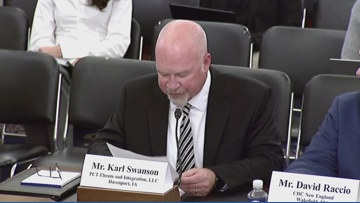Report on Educational Disparities in Lynchburg City Schools and Alignment with Sustainable Development Goals
Introduction
An investigation into the Lynchburg City Schools (LCS) division reveals significant educational disparities, directly challenging the principles of several United Nations Sustainable Development Goals (SDGs). The resignation of a key education advocate, Mr. Danny McCain, from a committee established to address a persistent racial achievement gap, underscores a critical failure in advancing SDG 4 (Quality Education) and SDG 10 (Reduced Inequalities). This report analyzes the data, the institutional response, and the direct implications for achieving these global goals at a local level.
Analysis of the Educational Achievement Gap: A Challenge to SDG 4
The core issue identified in Lynchburg City Schools is the substantial and long-standing achievement gap between Black and white students. This disparity represents a fundamental barrier to achieving SDG 4, which aims to ensure inclusive and equitable quality education for all. Data compiled by Mr. McCain from the Virginia Department of Education illustrates a systemic problem.
Key Data Findings (2023-2024 SOL Pass Rates)
- 3rd Grade English Reading:
- White Students: 76.83%
- Black Students: 36.22%
- 3rd Grade Math:
- White Students: 81.10%
- Black Students: 43.08%
- 8th Grade English Reading:
- White Students: 80.00%
- Black Students: 41.25%
- 8th Grade Math:
- White Students: 42.86%
- Black Students: 27.14%
These figures, which show failure rates exceeding 50% for Black students in core subjects, indicate that a significant portion of the student population is being left behind, in direct opposition to the equity targets of SDG 4.
Institutional Response and Governance: A Test of SDG 16
The controversy surrounding the school board’s ad hoc committee highlights challenges related to SDG 16 (Peace, Justice and Strong Institutions), which calls for effective, accountable, and inclusive institutions at all levels.
Chronology of Events
- An education advocate, Danny McCain, who has tracked the achievement gap for 25 years, repeatedly presented his findings to the LCS board.
- The board established an ad hoc committee to address the issue, appointing Mr. McCain as a member.
- Mr. McCain resigned from the committee, citing a perceived lack of seriousness and genuine commitment from the board to enact meaningful change.
- The advocate suggested that institutional reforms, such as moving to an elected school board, are necessary to ensure accountability.
The school board maintains its commitment, with members stating that the solution requires a comprehensive, long-term effort. This divergence in perspectives on institutional effectiveness is a central component of the challenge outlined in SDG 16.
Implications for Sustainable Development
The situation in Lynchburg serves as a case study for the interconnectedness of the SDGs and the challenges of their local implementation.
Alignment with Key SDGs
- SDG 10 (Reduced Inequalities): The racial achievement gap is a clear manifestation of systemic inequality. Failing to provide equitable educational outcomes for Black students perpetuates cycles of social and economic disadvantage, undermining the core mission of SDG 10 to empower and promote the inclusion of all, irrespective of race.
- SDG 17 (Partnerships for the Goals): Both the advocate and the school board leadership agree that resolving the achievement gap extends beyond the school system. They acknowledge the need for a multi-stakeholder partnership involving the city council, community organizations, parents, and teachers. This consensus directly reflects the collaborative approach championed by SDG 17.
Conclusion
The educational disparities within Lynchburg City Schools represent a significant local challenge that mirrors global objectives for sustainable development. The persistent achievement gap is a direct affront to the goals of providing Quality Education (SDG 4) and Reducing Inequalities (SDG 10). The debate over the institutional response highlights the critical need for accountable and effective governance as stipulated in SDG 16. The universally acknowledged path forward—a broad, community-wide collaboration—reinforces the importance of Partnerships for the Goals (SDG 17) as the only viable strategy to ensure that no student is left behind.
SDGs Addressed in the Article
SDG 4: Quality Education
- The article’s central theme is the “achievement gap” in education, which directly relates to ensuring inclusive and equitable quality education. It highlights significant disparities in educational outcomes between black and white students in Lynchburg City Schools, focusing on fundamental subjects like reading and math.
SDG 10: Reduced Inequalities
- The article explicitly discusses inequality based on race within the education system. The persistent and widening gap in academic performance between black and white students is a clear example of an inequality of outcome that SDG 10 aims to address. The call for community and systemic change to tackle this issue aligns with the goal of reducing inequalities.
Specific Targets Identified
-
Target 4.1: By 2030, ensure that all girls and boys complete free, equitable and quality primary and secondary education leading to relevant and effective learning outcomes.
The article directly addresses this target by highlighting the lack of “equitable” and “quality” education, as evidenced by the low pass rates for black students in primary (3rd grade) and lower secondary (8th grade) education. The discussion of “socially promoting kids from one grade to the next” despite failing grades points to a failure in achieving “relevant and effective learning outcomes.”
-
Target 4.5: By 2030, eliminate gender disparities in education and ensure equal access to all levels of education and vocational training for the vulnerable, including persons with disabilities, indigenous peoples and children in vulnerable situations.
This target is relevant as it focuses on ensuring “equal access” for vulnerable groups. The article identifies black students as a group facing significant disadvantages and unequal outcomes within the education system, making them a “vulnerable” population in this context. The entire issue of the racial achievement gap is about the failure to provide equal access to quality educational outcomes.
-
Target 10.2: By 2030, empower and promote the social, economic and political inclusion of all, irrespective of age, sex, disability, race, ethnicity, origin, religion or economic or other status.
The educational disparities discussed in the article are a barrier to the social and economic inclusion of black students. Failing to provide an adequate education limits future opportunities and perpetuates cycles of inequality. The advocate’s efforts to bring the issue to the school board and city council are an attempt to promote inclusion and demand action for a specific racial group.
-
Target 10.3: Ensure equal opportunity and reduce inequalities of outcome, including by eliminating discriminatory policies and practices and promoting appropriate legislation, policies and action.
This is a core target addressed by the article. The achievement gap is a clear “inequality of outcome.” The advocate’s resignation and public statements are a call for “policies and action” from the school board and city council to address the systemic problem. The debate over whether the school board is “serious” about tackling the issue relates directly to the implementation of actions to reduce this inequality.
Indicators for Measuring Progress
-
Proficiency in reading and mathematics:
The article provides explicit data that serves as a direct indicator of educational proficiency, disaggregated by race. This aligns with SDG Indicator 4.1.1 (Proportion of children and young people achieving at least a minimum proficiency level in reading and mathematics). The specific data points mentioned are:
- 3rd Grade Reading Pass Rates (2023-2024): 76.83% of white students passed, while 36.22% of black students passed.
- 3rd Grade Math Pass Rates (2023-2024): 81.10% of white students passed, while 43.08% of black students passed.
- 8th Grade Reading Pass Rates (2023-2024): 80% of white students passed, while 41.25% of black students passed.
- 8th Grade Math Pass Rates (2023-2024): 42.86% of white students passed, while 27.14% of black students passed.
-
Graduation Rates:
The article mentions that “black students are falling behind white students in… graduation rates.” While specific numbers are not provided, the difference in graduation rates between racial groups is an implied indicator used to measure the achievement gap and progress towards equitable secondary education completion.
-
Disparity in Educational Outcomes:
The “achievement gap” itself is a key indicator for Target 10.3. The size of the gap, measured by the percentage point difference in test scores between white and black students, can be tracked over time to measure whether inequalities of outcome are being reduced. The article notes the gap has been “spreading wider and wider” and “hasn’t closed at all,” using the gap itself as the primary metric of the problem.
Summary of Findings
| SDGs | Targets | Indicators |
|---|---|---|
| SDG 4: Quality Education |
4.1: Ensure equitable and quality primary and secondary education.
4.5: Ensure equal access to all levels of education for vulnerable groups. |
– SOL test pass rates in reading and math for 3rd and 8th graders, disaggregated by race. – Disparity in graduation rates between black and white students. |
| SDG 10: Reduced Inequalities |
10.2: Promote social and economic inclusion of all, irrespective of race.
10.3: Ensure equal opportunity and reduce inequalities of outcome. |
– The “achievement gap” itself, measured as the percentage point difference in SOL test pass rates between black and white students. – Data showing over 50% of black students are failing at every grade level, indicating a severe inequality of outcome. |
Source: wset.com







